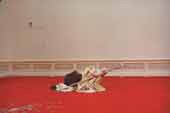-
- On 9 June the 49th International Exhibition of Visual Arts of the Biennale opens its doors under the direction of Harald Szeemann, who takes this year’s show as a further development upon the 48th Exhibition of 1999.
I would like to take this opportunity to tell you that 2001 is a year of key importance in the realization of the strategic objectives the new Biennale di Venezia has set itself, both at an organizational and artistic level.
- As far as the former is concerned, there has been an extension of planning capacity, which is indispensable if the Biennale di Venezia is to play an active role in its various fields of activity, and at the same time develop closer links with external organizations and bodies.
- A significant move in this area has been the creation of a single unit for Dance, Music and Theatre, which opens the way to more long-term planning in these three sectors.
The Biennale di Venezia is also establishing an increasing number of agreements with other institutions (universities, foundations, etc.) and of co production agreements with artistic bodies and theatres. Extended planning capacity is also essential if we are to promote new links with the public and establish new forms of dialogue with potential sponsors. Dialogues are currently in progress with important bodies both in Italy and abroad.
- Where possible, the Biennale di Venezia has also worked to create new well-equipped structures and spaces to serve as both exhibition and theatre facilities. In 2001 it is envisaged that a further 6-7 billion lire (2 million pounds) will be invested in the Arsenale restoration -primarily in providing better facilities for the performance and exhibition spaces created by the restoration of two years ago.
- 2001 is also the year of the starting of the first part of the special project involving ASAC (our important Archive collection), costing 4.5 billion lire, this three-year project will involve the reclassification of the collections and extensive digitalization.
In the meantime, the collection continues to grow, accumulating material relating to all the various activities of the Biennale di Venezia - an accumulation in which the Biennale offices have been assisted by Tele+ (Cinema) and RaiSat (other Sections).Communication with the public is also changing. The website in particular has grown very quickly; and now one can see it becoming an important portal for a whole range of activities in the arts.
These organizational developments have been the basis for further developments within the interdisciplinary work of the Biennale itself. The term “interdisciplinary” is not in our case a fashionable catchphrase; it refers to the fact that overlapping areas of interest emerge as each of various Sections of the Biennale works in its own specific field (whether collecting and exhibiting the works of others, or producing works “in house”). It is significant here that the first
multi-sectorial project of 2001 - “Shakespeare & Shakespeare” -grew up around an original Biennale co production of “Othello” by E.
Nekrosius, which took a full two years to bring to completion.
- The individual Sections are developing in their own fields according to their own priorities; and as they do so they provide concrete demonstration of the specific role that may be played by the Biennale di
Venezia.
So, whilst before, the Dance, Music and Theatre Sections used to host works from outside, their various programs now reveal the increasing presence of in-house workshops, new productions and newly-commissioned works - all of which show a direct involvement in the process of artistic creation.
- It includes, among numerous premieres, 12 new creations in which the Biennale plays a direct role as a producer (in many cases these in-house creations are a development upon ideas or works from previous Biennale events).
-
- As far as Cinema was concerned, the priority seemed to be the re-launch of a reorganized Film Festival, which would then make it possible to think of further additional initiatives or projects. Here again, within the limits of what was possible, we have worked to improve facilities whilst waiting for the promised building work that will make significant changes to the Palazzo del Cinema. More will be said about the Cinema Section in the traditional press conference to be held on 27 July.

